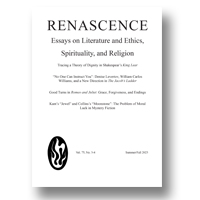|
|
|
1.
|
Renascence:
Volume >
65 >
Issue: 1
Ed Block, Jr., John E. Curran, Jr.
Editor’s Page
view |
rights & permissions
| cited by
|
|
|
|
|
|
|
2.
|
Renascence:
Volume >
65 >
Issue: 1
Melissa E. Sanchez
“Modesty or Comelines”:
The Predicament of Reform Theology in Spenser’s Amoretti and Epithalamion
abstract |
view |
rights & permissions
| cited by
Drawing on sixteenth-century Protestant discourse on marriage and sexuality, this essay examines the anxieties permeating Spenser’s two poetical celebrations of his courtship and wedding with Elizabeth Boyle. Though the Reformers’ departure from Rome included an embrace of clerical marriage and an advocacy for the virtues of companionate marriage, revulsion at the sinfulness of sex remained. Through the sonnets of the Amoretti and the stanzas of the Epithalamion, an idea of mutual love is disrupted by a Protestant-tinged sense of innate and pervasive depravity. Special attention is given to sonnets #58 and #84, and to the Epithalamion passages on Maia and Alcema.
|
|
|
|
|
|
|
3.
|
Renascence:
Volume >
65 >
Issue: 1
Robert W. Reeder
Before the Beginning:
John Donne on Creation, Birth, and Calling
abstract |
view |
rights & permissions
| cited by
Focusing on a 1628 Lenten sermon, this essay explores Donne’s handling of the complex problem of how we should conceive of time antecedent to the creation. Read in the light of Donne’s remarks elsewhere, and of those by St. Augustine, this sermon shows him considering pre-time time as an argument for the importance of vocation. Contemplation of the mystery of God’s activity before the creation yields a powerful idea of one’s life and calling as the surpassingly meaningful culmination of a vast process. Additionally, such contemplation helps Donne cope with the vagaries of his own life, especially his ties to Roman Catholicism, by contextualizing his own past-ness within the larger story of humanity’s sin and redemption.
|
|
|
|
|
|
|
4.
|
Renascence:
Volume >
65 >
Issue: 1
Denna Iammarino
“From that day forth I cast in careful mynd, / to seeke her out with labor, and long tyne”:
Spenser, Augustine, and the Places of Living Language
abstract |
view |
rights & permissions
| cited by
In light of the ramifications for Spenserian hermeneutics in the Proems to Books Two (“unseen” reality) and Three (“living art”) of The Faerie Queene, this essay reads Prince Arthur’s account of his dream-vision of Gloriana (1.9) as an allegory for how the reader ideally should encounter and make meaning from the poet’s text. Spenser’s concept of “living art” echoes Dante’s “living language,” and both show the influence of Augustine, especially as regards the readerly agency called for in the Christian Doctrine and the Confessions. Places of textual obscurity (the “unseen”) mark opportunities for the reader to exercise and develop the capacity to generate interpretations, a process both the effect and the cause of virtue. This process is figured in Arthur’s memory of his dream of the Faerie Queen and how it inspires him to pursue her.
|
|
|
|
|
|
|
5.
|
Renascence:
Volume >
65 >
Issue: 1
Jill Phillips Ingram
“You ha’done me a charitable office”:
Autolycus and the Economics of Festivity in The Winter’s Tale
abstract |
view |
rights & permissions
| cited by
Considering what social and economic historians have argued about the reinforcement of societal obligations in English festival culture, still functional in a Protestant context, this essay looks at how a specific Shakespearean character exemplifies the normative interpenetration of the self-interested and the communal. Festivals foster a religious sensibility intertwining, in complex ways, spiritual with economic gain. Through his part within the atmosphere of festivity, reconciliation, and salvation at the end of The Winter’s Tale, Autolycus proves the symbiosis of commerce and charity.
|
|
|
|
|
|
|
6.
|
Renascence:
Volume >
65 >
Issue: 1
Notes on Contributors
view |
rights & permissions
| cited by
|
|
|
|





